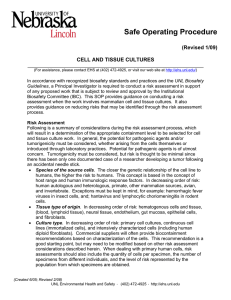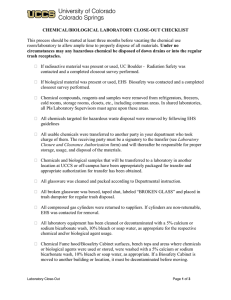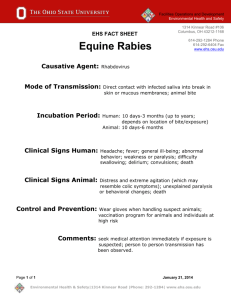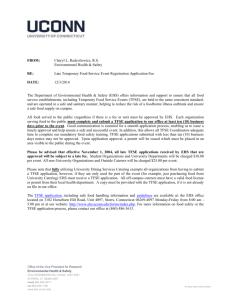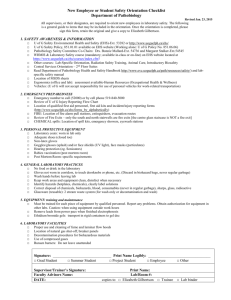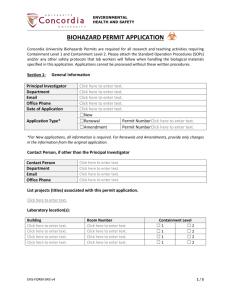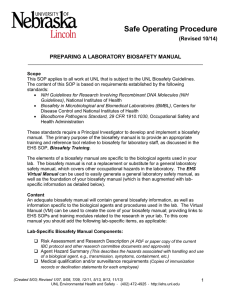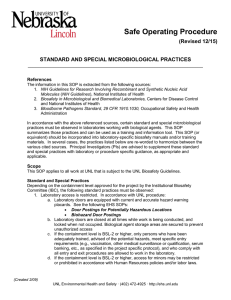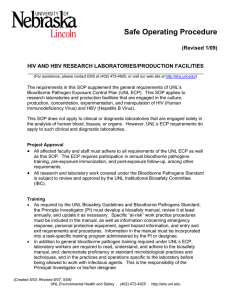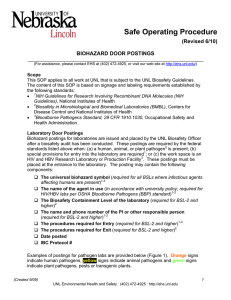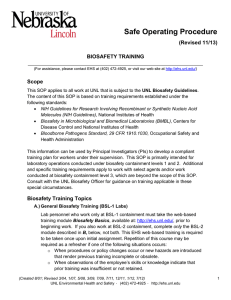Biosafety Manual Table Of Contents Form
advertisement
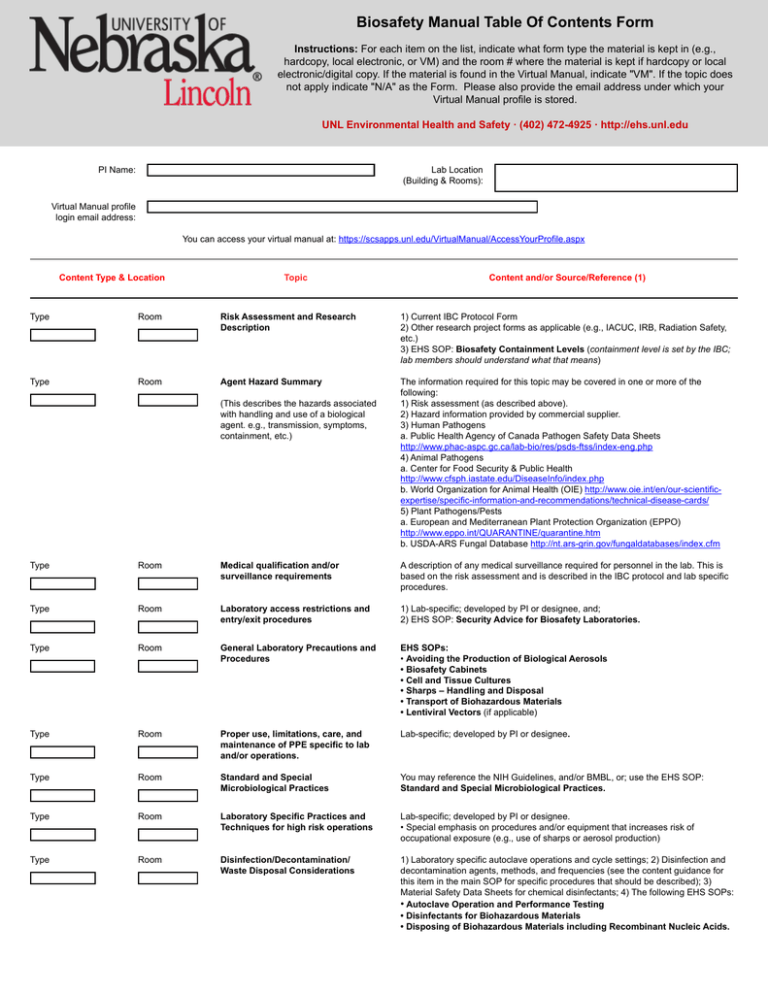
Biosafety Manual Table Of Contents Form Instructions: For each item on the list, indicate what form type the material is kept in (e.g., hardcopy, local electronic, or VM) and the room # where the material is kept if hardcopy or local electronic/digital copy. If the material is found in the Virtual Manual, indicate "VM". If the topic does not apply indicate "N/A" as the Form. Please also provide the email address under which your Virtual Manual profile is stored. UNL Environmental Health and Safety · (402) 472-4925 · http://ehs.unl.edu PI Name: Lab Location (Building & Rooms): Virtual Manual profile login email address: You can access your virtual manual at: https://scsapps.unl.edu/VirtualManual/AccessYourProfile.aspx Content Type & Location Topic Content and/or Source/Reference (1) Type Room Risk Assessment and Research Description 1) Current IBC Protocol Form 2) Other research project forms as applicable (e.g., IACUC, IRB, Radiation Safety, etc.) 3) EHS SOP: Biosafety Containment Levels (containment level is set by the IBC; lab members should understand what that means) Type Room Agent Hazard Summary The information required for this topic may be covered in one or more of the following: 1) Risk assessment (as described above). 2) Hazard information provided by commercial supplier. 3) Human Pathogens a. Public Health Agency of Canada Pathogen Safety Data Sheets http://www.phac-aspc.gc.ca/lab-bio/res/psds-ftss/index-eng.php 4) Animal Pathogens a. Center for Food Security & Public Health http://www.cfsph.iastate.edu/DiseaseInfo/index.php b. World Organization for Animal Health (OIE) http://www.oie.int/en/our-scientificexpertise/specific-information-and-recommendations/technical-disease-cards/ 5) Plant Pathogens/Pests a. European and Mediterranean Plant Protection Organization (EPPO) http://www.eppo.int/QUARANTINE/quarantine.htm b. USDA-ARS Fungal Database http://nt.ars-grin.gov/fungaldatabases/index.cfm (This describes the hazards associated with handling and use of a biological agent. e.g., transmission, symptoms, containment, etc.) Type Room Medical qualification and/or surveillance requirements A description of any medical surveillance required for personnel in the lab. This is based on the risk assessment and is described in the IBC protocol and lab specific procedures. Type Room Laboratory access restrictions and entry/exit procedures 1) Lab-specific; developed by PI or designee, and; 2) EHS SOP: Security Advice for Biosafety Laboratories. Type Room General Laboratory Precautions and Procedures EHS SOPs: • Avoiding the Production of Biological Aerosols • Biosafety Cabinets • Cell and Tissue Cultures • Sharps – Handling and Disposal • Transport of Biohazardous Materials • Lentiviral Vectors (if applicable) Type Room Proper use, limitations, care, and maintenance of PPE specific to lab and/or operations. Lab-specific; developed by PI or designee. Type Room Standard and Special Microbiological Practices You may reference the NIH Guidelines, and/or BMBL, or; use the EHS SOP: Standard and Special Microbiological Practices. Type Room Laboratory Specific Practices and Techniques for high risk operations Lab-specific; developed by PI or designee. • Special emphasis on procedures and/or equipment that increases risk of occupational exposure (e.g., use of sharps or aerosol production) Type Room Disinfection/Decontamination/ Waste Disposal Considerations 1) Laboratory specific autoclave operations and cycle settings; 2) Disinfection and decontamination agents, methods, and frequencies (see the content guidance for this item in the main SOP for specific procedures that should be described); 3) Material Safety Data Sheets for chemical disinfectants; 4) The following EHS SOPs: • Autoclave Operation and Performance Testing • Disinfectants for Biohazardous Materials • Disposing of Biohazardous Materials including Recombinant Nucleic Acids. Type Room Emergency Procedures 1) Emergency telephone numbers- 911, UNLPD, EHS, and lab contacts (advisable to post next to telephone as well); 2) Location of building specific alarms, evacuation routes, and gathering locations; 3) Location, content, and limitations of laboratory spill supplies; 4) the following EHS SOPs: • On-the-Job & Student Injuries • Incident Reporting- National Institutes of Health (NIH) Guidance • Spill and Exposure Response for Biohazardous Materials. Type Room Bloodborne Pathogens Program Materials • Select the “Bloodborne Pathogens” in your VM. • Copies of immunization records or declination statements for each employee. • Local copies of the Enrollment Checklist and Lab-specific Training Verification Form and BBP Exposure Care Kit (downloaded through VM) • EHS SOP: Cleaning up Spills of Biohazardous Materials Type Room Permits for possession, transfer or use of restricted agents from CDC or USDA/APHIS A copy of these permits should be attached to your IBC protocol, but it is recommended to keep a copy in your biosafety manual as well. Type Room Training records (EHS and lab-specific) • EHS SOP: Biosafety Training • Training records should be maintained for the lab. EHS can provide a copy of personnel training history for online training courses, but lab-specific and biosafety refresher training must be documented by the lab. Additional Manual Content not covered by the above topics (1) All EHS SOPs referenced above are accessible from the Virtual Manual when you add “Biological Agents” and “Bloodborne Pathogens” to your profile. Contact the UNL Biosafety Officer with any questions about this form at 402-472-9554.

